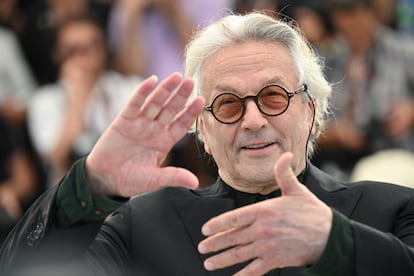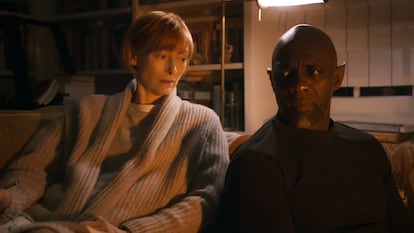George Miller, director of ‘Mad Max’ series: ‘In the end, it’s all about surviving’
The Australian filmmaker is releasing ‘Three Thousand Years of Longing,’ which describes the relationship between a scholar and a djinn that comes out of a bottle


Australian director George Miller has a mischievous look about him.
He laughs. “Well, if that’s what I look like to you, you should meet my brother John.”
George and John were inseparable for the first 22 years of their lives, even studying medicine together. “In our isolated rural childhood there was no television, only a cinema with matinees on Saturdays, so my greatest youthful entertainment were the stories that John told me.”
The conversation about storytellers is particularly relevant, as Miller promotes the film Three Thousand Years of Longing, which was released in American theaters on August 26. In the film, British actress Tilda Swintown plays Dr. Alithea Binnie, a lonely literature professor who, while on a trip to Istanbul, rubs a small bottle from which a djinn emerges. The djinn – played by Idris Elba – naturally grants her three wishes… but Dr. Binnie refuses the offer, fearing that it will end badly. To convince her to accept the wishes, the djinn tells her stories from his troubled past.
The interview took place in May at the Cannes Film Festival, where the movie premiered and is now being released worldwide. Miller then returned to Australia, where he began filming Furiosa, the prequel to Mad Max: Fury Road, in which Anya Taylor-Joy will play a leading role alongside Chris Hemsworth.
Miller’s youthful appearance and energy almost make one forget that he is 77 years old. His smile hides a devilish and eclectic mind: he is best known as the director of the Mad Max saga, but has also been behind Babe, Lorenzo’s Oil and Happy Feet. He acknowledges that his style is meticulous. Mad Max: Fury Road took three years to film and release. Furiosa, meanwhile, is set to come out in May 2024.

“My whole life has been based on telling stories. Now, not all of them are fairy tales and I would dare to say that this one isn’t either,” he points out, referring to Three Thousand Years of Longing. “I like stories, because they help you empathize with others… in short, they help me live.”
Swinton’s character believes that every legend can be explained through logic and science… until the djinn disarms her. Miller is fascinated with mythology, especially its pedagogical side. “Mythologies and religions were born from [asking questions]. Science tries to respond.”
“Myths are the tools that humanity once used to pass on knowledge. I don’t believe in strange creatures or legends; on the other hand, I dedicate myself to cinema!”
The director understands that storytelling is the most original method that humans have to communicate: “It’s the format in which we tend to express ourselves. We’ve been through a pandemic… and the descriptions of the numerous medical heroics have been adapted to that narrative scheme. Like in sports victories.”
In Three thousand Years of Longing, curiosity is defended as a vital engine. For the Aussie, storytelling ability and curiosity are equally important. “When they ask me what’s the most necessary tool to make good cinema, there’s no doubt: curiosity. And the best narratives germinate from it. The dullest people are the ones who have lost their curiosity.”
Although Miller has shot a handful of classics and action movies, he has never made a superhero film. But that’s not really his thing.
“I think the only superheroine [in this film] is the narration… I have played with a certain distance, in which the story reaches the viewer through the voice of the scholar, who in turn warns about the extraordinary thing that she is going to tell. You need your audience to be open-minded.” This movie, he says, is a fable about a djinn at a time when we no longer believe in them, when agnosticism has triumphed. “That’s why, like every film director, I ask for some credulity from the audience.”
A new journey in the Mad Max saga begins #FURIOSA pic.twitter.com/nhxqRXB73z
— Chris Hemsworth (@chrishemsworth) June 1, 2022
In much of Miller’s work, the landscape in which his protagonists move is post-apocalyptic, in the broadest sense of the word. His characters go through huge challenges and processes of reconstruction.
“Drama, since the beginning of time, is born from something inherent to the human being. Conflict, a constant of narration, appears in whichever artistic format the human condition is captured in. And what goes together with conflict? Fear.” And there is no greater fear, he says, than facing life after someone or something has shattered your world into pieces.
“Who saw the pandemic coming? Who prepared us for it? No one. We had to adapt to new circumstances, invent explanations to calm our fears… which is an ancient process within humanity. It’s the flickering candle in a dark house in the deepest night.”

Tu suscripción se está usando en otro dispositivo
¿Quieres añadir otro usuario a tu suscripción?
Si continúas leyendo en este dispositivo, no se podrá leer en el otro.
FlechaTu suscripción se está usando en otro dispositivo y solo puedes acceder a EL PAÍS desde un dispositivo a la vez.
Si quieres compartir tu cuenta, cambia tu suscripción a la modalidad Premium, así podrás añadir otro usuario. Cada uno accederá con su propia cuenta de email, lo que os permitirá personalizar vuestra experiencia en EL PAÍS.
¿Tienes una suscripción de empresa? Accede aquí para contratar más cuentas.
En el caso de no saber quién está usando tu cuenta, te recomendamos cambiar tu contraseña aquí.
Si decides continuar compartiendo tu cuenta, este mensaje se mostrará en tu dispositivo y en el de la otra persona que está usando tu cuenta de forma indefinida, afectando a tu experiencia de lectura. Puedes consultar aquí los términos y condiciones de la suscripción digital.
More information
Últimas noticias
Most viewed
- Oona Chaplin: ‘I told James Cameron that I was living in a treehouse and starting a permaculture project with a friend’
- Sinaloa Cartel war is taking its toll on Los Chapitos
- Reinhard Genzel, Nobel laureate in physics: ‘One-minute videos will never give you the truth’
- Why the price of coffee has skyrocketed: from Brazilian plantations to specialty coffee houses
- Silver prices are going crazy: This is what’s fueling the rally










































